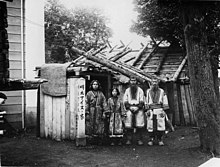
Back الاينو فى روسيا ARZ Ainu di Rusia ID ロシアにおけるアイヌ Japanese Айны в России Russian Aini u Rusiji Serbian Россиядә айнулар Tatar 阿伊努裔俄羅斯人 Chinese
 | |
 Karafuto Ainu house, 1912 | |
| Total population | |
|---|---|
| 300 (official Russian Census 2021)[1] 1,000 to +100,000[citation needed] (not federally recognized) | |
| Regions with significant populations | |
| Sakhalin Oblast, Khabarovsk Krai and Kamchatka Krai | |
| Languages | |
| Russian, formerly Ainu languages (Kuril†, Sakhalin†) | |
| Religion | |
| Russian Orthodox and Shamanism (see Ainu mythology) | |
| Related ethnic groups | |
| Hokkaido Ainu, Kamchadals, Ryukyuans,[2] Jōmons |




The Ainu in Russia are an Indigenous people of Siberia located in Sakhalin Oblast, Khabarovsk Krai and Kamchatka Krai. The Russian Ainu people (Aine; Russian: айны, romanized: Ayny), also called Kurile (курилы, kurily), Kamchatka's Kurile (камчатские курилы, kamchatskiye kurily / камчадальские айны, kamchadalskiye ayny) or Eine (эйны, eyny), can be subdivided into six groups.
Although only around 100 people currently identify themselves as Ainu in Russia (according to the census of 2010), it is believed that at least 1,000 people are of significant Ainu ancestry. The low numbers identifying as Ainu are a result of the refusal by the government of the Russian Federation to recognise the Ainu as a "living" ethnic group. Most of the people who identify themselves as Ainu live in Kamchatka Krai, although the largest number of people who are of Ainu ancestry (without acknowledging it) are found in Sakhalin Oblast. Many local people are ethnically Ainu or have significant Ainu ancestry but identify as Russian or Nivkh and speak Russian as mother tongue, often not knowing of their Ainu ancestry.[3]
- ^ "2. СОСТАВ ГРУППЫ НАСЕЛЕНИЯ "УКАЗАВШИЕ ДРУГИЕ ОТВЕТЫ О НАЦИОНАЛЬНОЙ ПРИНАДЛЕЖНОСТИ"". Archived from the original on 15 September 2023. Retrieved 15 September 2023.
- ^ "Ryukyuan, Ainu People Genetically Similar". 5 December 2012.
- ^ "The Ainu: One of Russia's indigenous peoples: Voice of Russia". Archived from the original on 5 March 2012. Retrieved 22 February 2012.